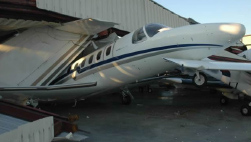By Charlotte Adams
 If you are a small to medium-sized, independent aircraft repair facility and, out of the blue, you get a call from the National Transportation Safety Board (NTSB) or the Federal Aviation Administration (FAA) as part of an ongoing investigation of an aircraft accident, what should you do? Or worse still, if you are unexpectedly contacted by plaintiff’s lawyer or by someone with a badge who is demanding your records, what do you do?
If you are a small to medium-sized, independent aircraft repair facility and, out of the blue, you get a call from the National Transportation Safety Board (NTSB) or the Federal Aviation Administration (FAA) as part of an ongoing investigation of an aircraft accident, what should you do? Or worse still, if you are unexpectedly contacted by plaintiff’s lawyer or by someone with a badge who is demanding your records, what do you do?
Experts contacted by Aviation Maintenance agree that it’s important to be prepared for a worst-case scenario. If a facility has an “early warning system” in place, along with a plan of what to do if the worst should happen, fast-moving events that follow in the wake of an accident are less likely to negatively affect your business.
A facility’s early warning system could include looking periodically at the NTSB’s daily updated aviation accident database page (http://www.ntsb.gov/aviationquery/Month.aspx), the FAA’s preliminary accident/incident report page (http://www.asias.faa.gov/pls/apex/f?p=100:93:0::NO:::) and news media reports in order to anticipate whether there could be some involvement in an investigation or potential exposure to a lawsuit. In general aviation (GA) the possibility of a lawsuit appears more likely than the possibility of participating in an NTSB investigation.
Also “it would behoove you,” especially if you are working on flight-critical components, “to have a methodology in place for ensuring you will be contacted by the owner/operator…” if anything happens, says Sarah MacLeod, executive director of the Aeronautical Repair Station Association (ARSA).
It’s also important to notify your insurance carrier immediately so that it can assess the situation and hire a lawyer to advise you in the NTSB process or defend your interests in a liability lawsuit. Although the purpose of an NTSB investigation is to determine probable cause, not liability, lawsuits frequently follow in the wake of the agency’s final report.
Plaintiffs’ lawyers can’t submit the probable cause report as evidence in a liability suit, but they can use the NTSB’s factual report and they can depose the same people that the aviation authorities consulted. Even though the NTSB’s determination of probable cause may have implicated pilot error, the lawyers representing an injured passenger or the passenger’s widow, for example, may develop a completely new theory, perhaps involving maintenance. The repair facility may not hear of this potential lawsuit until some years after the investigation has been completed.
[s2If is_user_logged_in()]
READ FULL STORY >>>
[/s2If]
[s2If is_user_not_logged_in()]
[message_box title=”To READ the full article in our digital edition you need to be a registered subscriber to the magazine – If you are NOT then goto the SUBSCRIBE section of the site first before you can login” color=”green”]
[/message_box]
[/s2If]